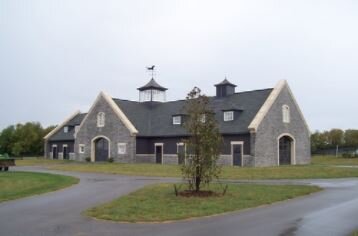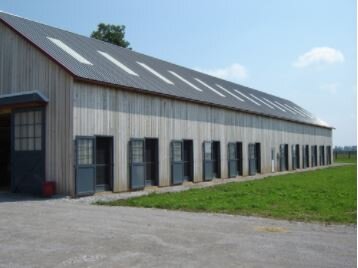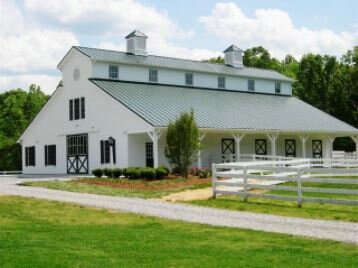Basic Needs: Shelter and Space-Building a House for a Horse
All organisms, both plants and animals, have basic needs. These needs include nutrients from the food they eat, and most need oxygen and sunlight too. Plants need space to spread their stems and leaves to “capture” sunlight in order to make their own food through photosynthesis. Animals may need shelter and the right range of temperatures to help them meet their needs so they can carry out life’s basic functions to grow and develop, use energy, reproduce, respond to their environment, and get rid of waste.
GRADE LEVEL
3rd & 4th Grade Science
Secondary Agriculture
OBJECTIVES
Students will be introduced to the basic needs and functions of living things.
Students will be introduced to stimulus and response.
Students will develop an understanding of the basic needs of shelter and space as they relate to horses.
Students will build structures using common materials and explore ways to solve problems when building structures.
Students will explore how large objects or structures can be made from smaller parts.
NEXT GENERATION SCIENCE STANDARDS
3-LS4-3. Construct an argument with evidence that in a particular habitat some organisms can survive well, some survive less well, and some cannot survive at all.
3-ESS3-1. Make a claim about the merit of a design solution that reduces the impacts of a weather-related hazard.
4-LS1-1. Construct an argument that plants and animals have internal and external structures that function to support survival, growth, behavior, and reproduction.
4-LS1-2. Use a model to describe that animals receive different types of information through their senses, process the information in their brain, and respond to the information in different ways.
Engineering and Design
3-5.ETS1-1. Define a simple design problem reflecting a need or want that includes specified criteria for success and constraints on materials, time, or cost.
3-5.ETS1-2. Generate and compare multiple possible solutions to a problem based on how well each is likely to meet the criteria and constraints of the problem.
BACKGROUND INFORMATION
All organisms, both plants and animals, have basic needs. These needs include nutrients from the food they eat, and most need oxygen and sunlight too. Plants need space to spread their stems and leaves to “capture” sunlight in order to make their own food through photosynthesis. Animals may need shelter and the right range of temperatures to help them meet their needs so they can carry out life’s basic functions to grow and develop, use energy, reproduce, respond to their environment, and get rid of waste.
Horses have a physical adaption to keep themselves warm by growing a winter coat. The longer hairs provide insulation by trapping heat next to the skin, warming up the air close to the body. Another adaption is shivering, like people do. Shivering is a reflex to cold temperatures and a response by our bodies to release more energy from our muscles to maintain our internal body temperatures. This response happens in horses too. In other words, shivering is simply the body’s response to an outside stimulus (something that makes you react in a certain way): the cold temperature sends a message to the brain where it interprets the information (I’m cold), and the brain sends out a message for a reaction (time to shiver).
Horses need shelter to protect their skin and coats from the elements of colder weather in the winter and biting insects and the sun in the hot summers. Horses may spend part of their day in a room called a stall. In Kentucky, Thoroughbred farms tend to use the stalls, stables, or barns (building with many stalls) for feeding, medical check-ups, and treatments, a break from biting insects, and protection from very cold temperatures in wet conditions. In Kentucky, you may see horses covered in blankets during the coldest days. Horses burn body fat trying to keep warm. Older horses, and horses who need to maintain or grow their body weight may be dressed in a blanket to prevent the loss of calories.
Stalls may have openings that allow the horse to stick-out their heads to see each other. Horses are social and herding animals and prefer to be in the company of other horses.
Because horses are large herding animals, they require lots of space to graze on grasses, stretch, and exercise their long legs. Many horses are happiest outside and will choose the field or paddock, a small enclosed field, over the barn/stable or stall given the choice. The combination of stables and open grassy fields provide horses with the habitat that helps meet their needs to carry out their basic functions for life.
Horses are quite comfortable in most temperatures. Typically, most horses are “turned-out” or released to the fields in the later afternoon and stay in the field throughout the night. In the early morning the horses are led into the stalls by the groomers or handlers for a look-over to check eyes, posture, injuries, and overall health. Once in the stall, the horse is groomed, and fed. Thoroughbreds have regular medical check-ups just like you. A doctor who cares for the needs of an animal is called a veterinarian. Horses receive vaccinations to keep them healthy just like you too.
The standard stall is typically 10 feet wide by 10 feet long for horses smaller than 1,000 pounds and at least 12 feet by 12 feet for horses 1,000 pounds or larger or mares with foals. A bedding material such as straw or soft wood shavings will be placed on the floor of the stall. This bedding provides comfort, will soak up the horse’s urine, and reduces contact with manure. A stall should be “mucked” at least once a day (manure and wet bedding is removed, and fresh straw or shavings are placed in the stall). Many farms will use rubber floor mats in the stalls because it is easier on the horse’s legs in comparison to concrete flooring or dirt floors.
SUPPLIES/RESOURCES
popsicle sticks
scissors
cardboard
foam board
toothpicks
yarn or string
pipe cleaners
glue bottles
rulers
colored pencils
student information and design worksheets (see button at the top)
TEACHER SUGGESTIONS
This group activity can be done in groups of 3-4. Each group will need rulers to help them design their blueprint.
To save time, pre-cut the string in strips of one-yard lengths, bundle popsicle sticks in groups of 25, and pre-cut cardboard and foam board into 5X5 squares, bundle toothpicks in groups of 25.
This activity will take 2-3 class periods to complete. Providing each group with a shoebox to keep their materials could help students stay organized and your room tidy.
Print the different bills of money on different colors of paper. For example, $1 on blue, $5 on yellow, and $10 on green, and so on. View the file.
Each group will need:
20 $1 bills
16 $5 bills
10 $10 bills
10 $20 bills
6 $100 bills
Pre-printed money is included in the for-purchase kit referenced under supplies.
You could assign one student to be the banker. This student could check each student’s order to be sure the calculations are correct and dispense the supplies. This would free the teacher to monitor the groups as they work.
In the event you do not have access to play money, students can calculate their expenses on their lab worksheet. Tell them not to exceed $1,000.
Videos or pictures of barns, stables, and stalls can help students visualize the concept of what they are building.
Set-up a “wind-tester” by using a small fan. A stopwatch can be used to determine how many minutes/seconds the structure held or create a pre-designated time that a structure must withstand.
Awards could be given to the stable that looks most like the blueprint, the stable that weathers the wind best, the least costly that met all the criteria, etc.
Science concepts to discuss prior to the passage or within the passage:
Stimulus/response
Physical adaptation
Basic needs of all organisms
Basic Functions of Life
Terms that may need further explanation from the teacher:
Blueprint
CURRICULUM SPONSORS
CREDITS
Written by Jennifer McNulty
Design by Jennifer Elwell












